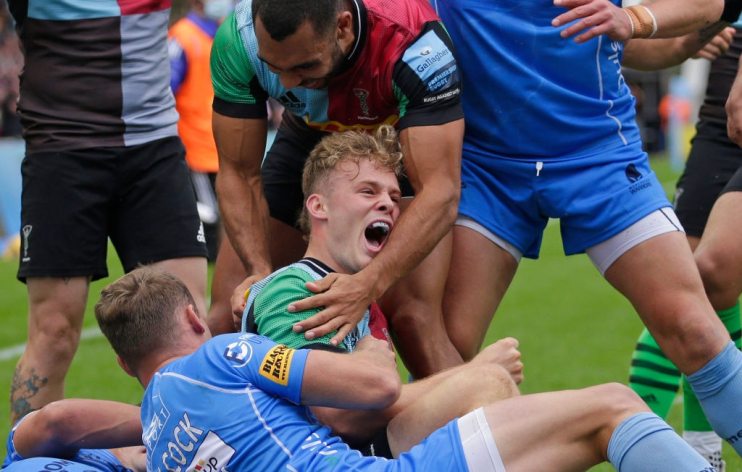World Rugby’s 15 minute contact limit: the solution to injury fears or too simplistic?

Rugby’s physically demanding nature has seen the sport’s organisers implement advanced concussion policies and a science-based approach to medicine, but they are about to go further.
World Rugby, the game’s international governing body, last month issued the recommendation that players be limited to 15 minutes of full-contact training per week, across a maximum of two days, from 2023.
The guidelines, which are not mandatory, also include capping set-piece, scrum and line out training at 30 minutes per week and controlled contact training at 40 minutes.
“We have a responsibility to make the game as safe as possible for all our players,” said former England head coach Stuart Lancaster, now of Leinster.
“For coaches, optimising training plays a significant role in achieving that objective. It is important that we do not overdo contact load across the week in order that players are fresh, injury-free and ready for match days.
“These guidelines provide a practical and impactful approach to this central area of player preparation and management.”
World Rugby’s recommendations are a response to growing concerns and related legal action around the link between repeated blows and dementia.
One of the changes demanded by a group of former players, including 2003 World Cup winning former England hooker Steve Thompson, who are suing World Rugby is a reduction in contract training.
The governing body set its guidance at 15 minutes per week after canvassing almost 600 men’s and women’s players. It found the average amount of full-contact training was 21 minutes, though the worst offending team had more than two hours of contact.
But is a time limit the best way to safeguard players? An alternative method, used by current Premiership champions Harlequins, is to measure both the quality and quantity of impacts using smart mouthguards.
The Protecht mouthguards can assess impact loads in real time and give personalised feedback to clubs for each player. The technology has reduced injuries and increased player availability at Quins, says Chris Turner, chief executive of Sport and Wellbeing Analytics, which makes the mouthguards.
“Contact is not actually very well measured at the moment. If you look at how people have historically measured contact, they’ve counted them up and they’ve gone one, two, three, four,” said Turner.
“The problem with that is that it doesn’t discriminate between what’s a big impact and what’s a little impact. They all count the same. We don’t know what is a heavy impact or a light impact, so we’ve come up with a complete lexicon to describe all of that. And when we’ve got that lexicon we can impose on top of that what normal looks like.”
Harlequins began using the technology last season, applying data from matches to significantly reduce contact in training by 40 to 60 per cent, and sometimes even more. The club publicly cited Protecht as a factor in their victorious campaign. Their findings suggest players are better served by individual plans.
“Our view is that 15 minutes in just an arbitrary number,” says Turner. “It’s about managing that contact load. So different players can take more or less of this. Different players have different physical characteristics. Some can endure more, some can’t.
“Glancing blows at high speed, outside of full contact, can be just as impactful. The advantage of managing contact by load is that you’re not constrained by a specific length of time, you’re constrained by the load that the player is undertaking. And if an exercise takes a bit longer, is that a problem? If it takes less time, is it a problem?”
Turner’s company shares its data with World Rugby and the governing body is backing calls to continue the research into technology such as the mouthguard.
The Rugby Players Association (RPA) is in favour of incorporating data in any limits on full-contact training.
“We welcome World Rugby and International Rugby Players’ new guidelines for rugby contact training load in the elite game,” said Richard Bryan, the RPA’s player welfare director.
“Our members participated in the International Rugby Players’ global study of 600 players that underpins the guidelines. It is a significant step.
“Ultimately, we believe that there should be limits on the amount of contact training that elite players are permitted to do but also appreciate the need to be led by data and science.
“We support the use of instrumented mouthguards in the Premiership to further our understanding.”
Player safety in impact sports has become more important than ever, and publicity surrounding the subject has propelled efforts to improve welfare. World Rugby, then, is at least heading in the right direction even if further advances may still be to come.
“I think the point to bear in mind is that there is currently no guidance so this from World Rugby is better than nothing,” said Turner.
For some ex-players, it can’t come soon enough. Former Scotland back row John Barclay wrote on Twitter: “A bit of common sense. World Rugby is limiting contact training training by 2023 to 15 minutes per week. Only question: Why wait until 2023?”